
How to calculate FBA fees
UK Amazon FBA fees explained: don't waste your money without realising it

Many sellers use Amazon marketplace to sell products and fulfil orders through a trusted name. The platform also provides the leverage sellers need to reach a wider customer base and is an excellent way to increase business revenue.
This article will explain the fulfilment aspect of Amazon’s services. FBA — or fulfilment by Amazon — helps ecommerce entrepreneurs simplify their business model and keep things running smoothly. But the service isn’t free.
So let’s break down how FBA works and the FBA fulfilment fees involved.
Table of contents
- A close look at Amazon FBA fees
- Benefits of fulfilment by Amazon
- Amazon FBA fees: an overview
- Amazon FBA fees for products sold on Amazon UK and other European stores
- Monthly inventory storage fees
- Multi-channel fulfilment by Amazon
- Other Amazon FBA charges to consider
- Conclusion
A close look at Amazon FBA fees
To properly explore FBA fulfilment fees, we’ll use an example of two individuals with ecommerce businesses, David and Hannah.
David runs his business independently. He is his own boss and has no employees. But it’s up to David to do everything in the business, including fulfilling orders. When a customer places an order, he must carefully pack and ship it to the customer.
Moreover, David has the responsibility of storing his products properly. And when a customer has an issue, he’s the customer service representative for the company. It may not be a big deal when selling one product. But as David intends to grow his business, he’ll find things more difficult as he scales. Plus, as a one-man-show, there’s a high probability for David to make an error somewhere along the way — mistyped addresses, poor packaging, etc.
Hannah delegated these tasks to fulfilment by Amazon. Her only responsibility is to mail her products to Amazon, and they take care of everything else.
Upon shipping, they store her products in a secure Amazon fulfilment centre. Then they’ll pack and ship the item to the customer safely and securely. If a customer has an issue, Amazon also takes care of the customer service.
Hannah’s chosen a professional organisation to take care of fulfilment every step of the way. With that choice, she can now scale her business and grow a wider customer base.
Benefits of fulfilment by Amazon
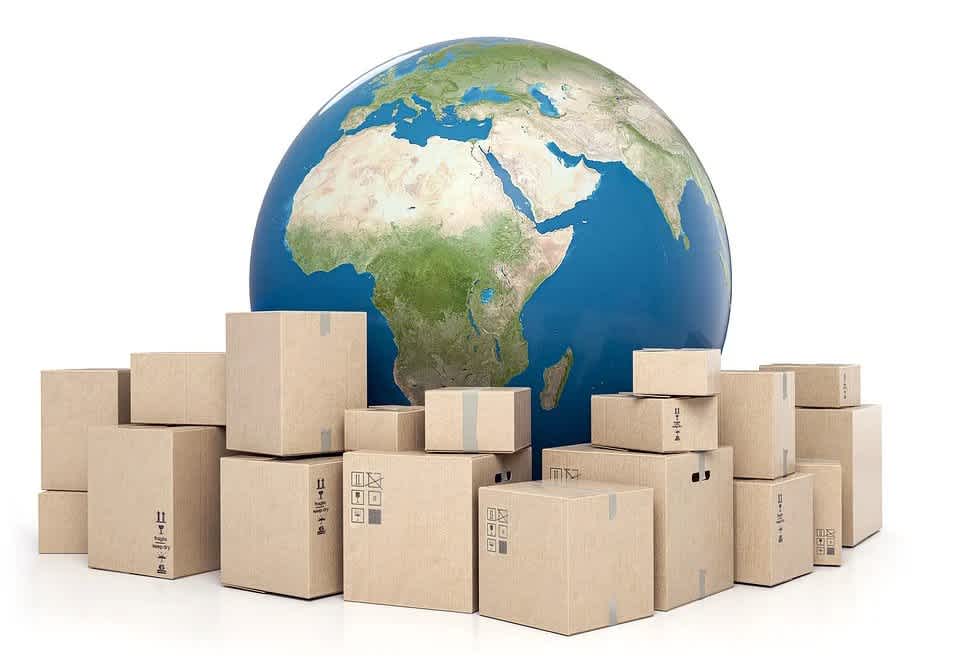
From the example of Hannah’s ecommerce business in the previous section, you can see how working with Amazon FBA can be highly beneficial. Here’s an overview of the key benefits:
Selling products through Amazon FBA gives your products automatic eligibility for Amazon Prime Shipping and the Amazon Prime logo on your product listings.
You'll have a higher chance to win in the Buyer’s Box — the box on the right side of a buyer’s page where they can add products to their cart. When multiple sellers have the same product in their inventory, Amazon uses an algorithm to determine who wins the sale in the Buyer’s Box. Working through FBA gives you an advantage in the algorithm.
Amazon fulfilment centres take care of your logistics. This allows you to shift the focus to other aspects of your business and scale it with ease. When things really take off, you’ll be able to store inventory and fulfil more orders with no growing pains.
Like Google, Amazon has a search algorithm, and it’s rumoured that sellers who work with FBA get ranked higher than ones who do not. Better rankings translate to higher sales numbers and more revenue.
One of the initial issues that slowed online shopping was the lack of a convenient returns process. Amazon removes this problem with their streamlined returns system and provides customer support to your customers. It’s a win-win.
Amazon FBA fees: an overview
Obviously, you won’t have access to all the benefits without paying something to Amazon. Amazon FBA fees depend on three elements:
Product weight
Product dimensions
Product sales channel — external site or the Amazon marketplace
Pricing categories
When choosing to fulfil orders through Amazon FBA, there are two price categories to take into consideration: fulfilment and storage.
FBA fulfilment fees are the fees paid to Amazon for their services. They cover picking the order at the warehouse, packing it for shipment, the actual shipping, customer service, and, if necessary, returns. Note that Amazon calculates these fees on a per-unit basis.
If you store your items at any Amazon fulfilment centre, you’ll incur inventory storage fees. Amazon charges storage fees based on the cubic feet of space occupied in the warehouse.
Sizing categories
Whether storage or shipping, Amazon FBA charges based on the weight and size of your products. To make things easier, Amazon has broken sizes into four categories.
Small and light - if your products fall within a low pricing and size category, they may be eligible to be fulfilled with Amazon FBA’s Small and Light Programme (details below).
Standard - Amazon defines this as a unit that’s 11.9kg or less, 45cm or less on its longest side, 34cm or less on its median side, and 26cm or less on its shortest side.
Oversize - anything above the standards set under the standard size category is oversize.
Special oversize - heavy bulky - if your oversized units are at least these dimensions: longest side >175cm OR girth >360cm OR weight >31.5kg, then they go under this last category.
Sizing subcategories
Under each of the sizing categories, there are subcategories (listed in the table below). Note the additional weight categories for oversize and special oversized items.
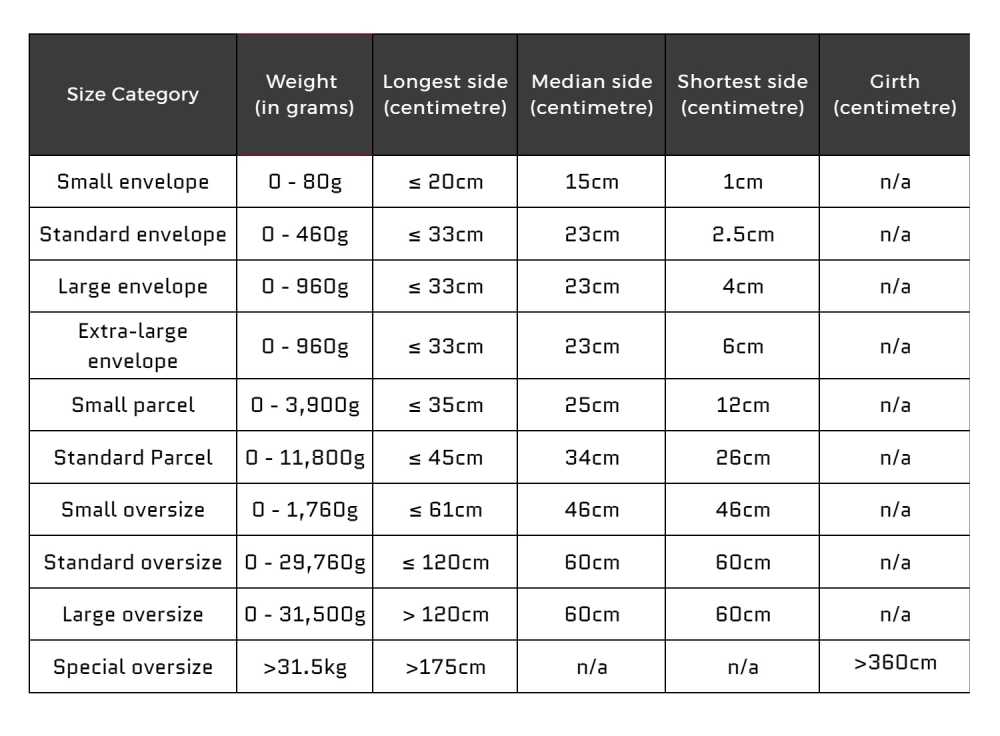
Amazon FBA pricing distinction
With the elements that make up the fulfilment fees understood, we’ll look into how the fees work into the different size categories. Remember, fees can come from the FBA fulfilment channel in three categories based on how you set up your inventory and where the order was placed.
Sell on Amazon.co.uk with fulfilment from inventory at Amazon UK
Sell on European Stores and fulfil from inventory at Amazon UK
Sell on European Stores with fulfilment from a local Amazon fulfilment centre
These also differ from self-fulfilment fees.
Amazon FBA fees for products sold on Amazon UK and other European stores

The pricing tables below display the sizing categories seen above alongside up-to-date pricing from March 31, 2022. The pricing covers all potential FBA fees sellers pay Amazon when using Amazon fulfilment centres. This includes picking, packing, shipping, and customer service. It’s all contingent on the size and weight of your packaging and product.
Standard Amazon FBA fulfilment fees

Amazon’s Small and Light Programme
If your products fall under all the following guidelines, then you can qualify for the Amazon FBA Small and Light Programme:
Priced at less than £9
Weigh less than or equal to 225g
Have dimensions less than or equal to 33 x 23 x 5 cm
The programme gives you access to free Prime shipping for your customers, a discounted fulfilment fee, and protection under Amazon’s A-to-Z Guarantee programme.
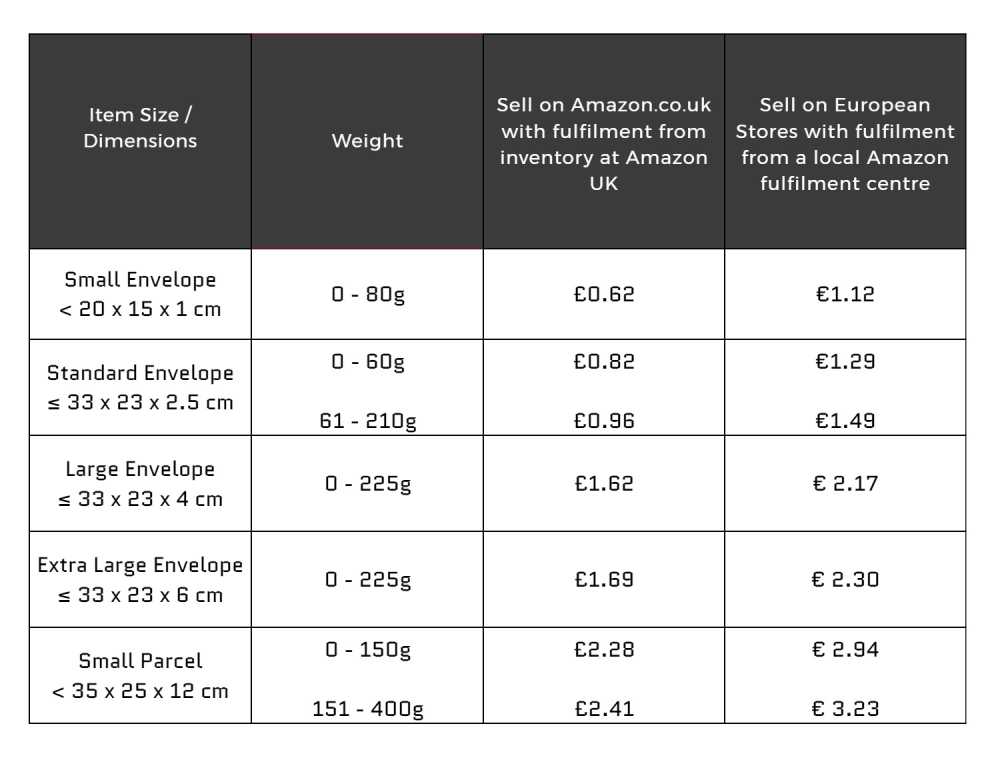
Amazon oversize
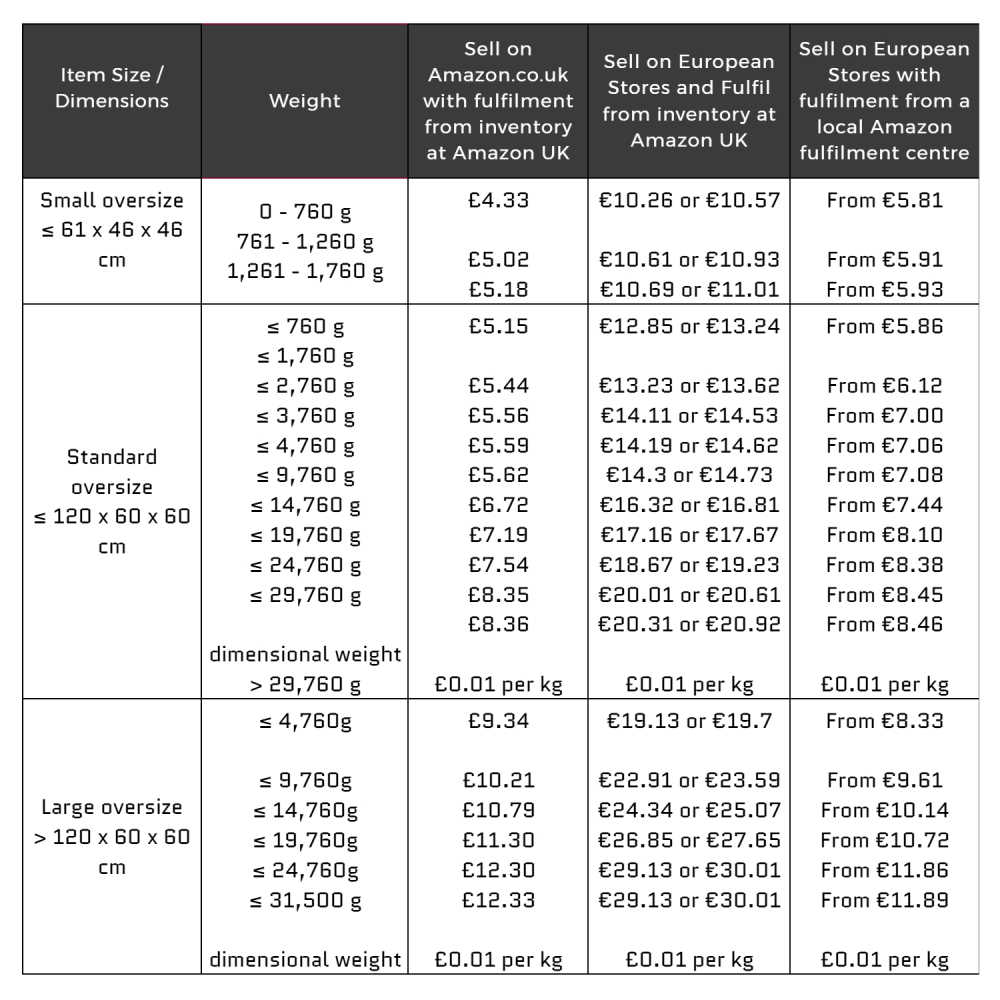
Amazon special oversize - heavy bulky

Monthly inventory storage fees
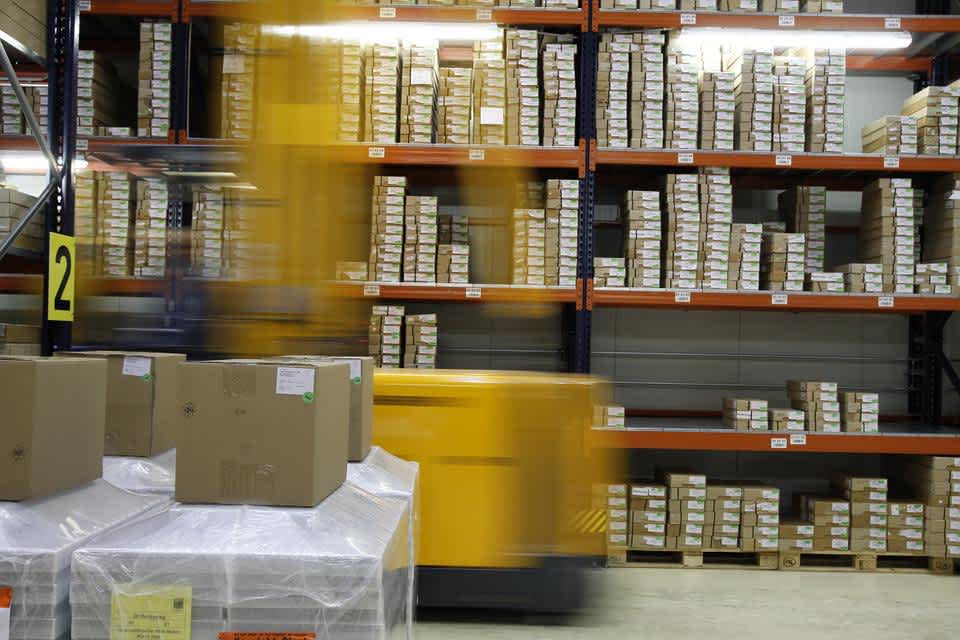
The other pricing category paid to Amazon falls under monthly storage fees. Amazon charges these fees between the 7th and 15th day of the month following the month the fee applied. This means a storage fee for the month of March will be charged between April 7th - 15th.
Regardless, FBA storage fees vary based on the product category and the month in which your product is at the fulfilment centre. From there, they charge a flat monthly fee based on the cubic foot. To get your product’s cubic foot measurement, use this formula:
Multiply length x width x height in centimetres to get the volume.
Then, divide the volume by 28,316.84 cubic centimetres (30.48 cm x 30.48 cm x 30.48 cm = 28,316.84), which is the equivalent of 1 cubic foot.
For example, a unit measuring 50 cm x 10 cm x 12 cm divided by 28,316.84 = 0.212 cu. Ft.
You can use the Amazon FBA Revenue Calculator to calculate this figure with ease.
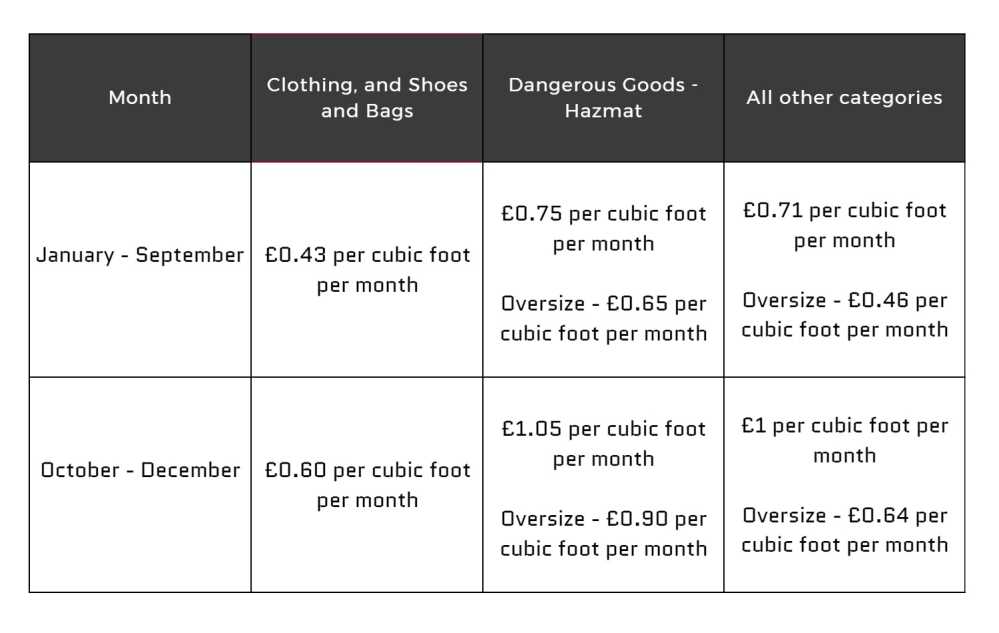
Long-term storage fees
If your items don’t sell, you will incur additional inventory storage fees. Long-term storage fees apply to inventory items that stay in a fulfilment centre for over 365 days. Amazon charges these fees on a monthly basis based on the category of the product.
Non-media items incur a monthly storage fee of £4.30 per cubic foot.
Media items incur the greater of either a monthly long-term storage fee of £4.30 per cubic foot or a minimum long-term storage fee of £0.10 per unit.
Amazon assesses inventory on the 15th of every month. There are different fees when fulfilling from European fulfilment centres.
Multi-channel fulfilment by Amazon
It’s possible to use Amazon FBA to sell products on channels outside of the Amazon marketplace. For example, if you already have a website dedicated to your product, it’s possible to use Amazon FBA to fulfil your orders. Amazon calls this programme Multi-Channel Fulfilment (MCF).
MCF pricing
The pricing tiers follow the same categories and sizing parameters. But by using this route, you avoid the monthly storage fees and potential for long-term storage fees through the fulfilment centre. However, the FBA cost is higher through multi-channel fulfilment, and there is a potential to incur additional fees if you don’t pack your products to Amazon’s specifications.
But you could save in the long run by avoiding some of the other Amazon fees covered in the next section. The Amazon FBA revenue calculator is a great resource to see which route is best for your business. But Amazon also has their multi-channel FBA fees on a convenient rate card.
Other Amazon FBA charges to consider
Using Amazon FBA can help your business scale quickly. But there are other fees to consider beyond the basic storage and fulfilment fees. If you’re not careful, they can eat into your profits quickly.
Selling plan fees
Amazon takes a monthly commission for the right to sell your products on their site. They offer two selling plans: individual and professional. The individual plan charges a rate of £0.70 per item sold, excluding VAT. The professional plan charges a monthly fee of £25 excluding VAT.
If you’re selling less than 35 items per month and aren’t sure of which market you want to enter, the individual plan is the way to go. But if you’re ready with a product and want advertising support from Amazon, it’s better to invest in the professional plan.
Just note that there could be additional selling fees under each programme.
Referral fees
Referral fees are outside of your selling plan. When you sell a product on Amazon, they charge a referral fee on the total price paid by the buyer for each item you sell — including the product and any gift wrapping charges. Amazon bases the fees on your product category, with most referral fees ranging between 8% and 15%. The minimum referral fee amount is always £0.25.
If you sell on another channel and use Amazon MCF for fulfilment, you will avoid referral fees.
Return processing fees
Amazon charges a fee when customers return products in the clothing, shoes, and handbag categories. The fee applies to each unit returned and is equal to 50% of the total fulfilment fee.
Removal order fees
If you have excess stock at a fulfilment centre and want Amazon to dispose of or remove it, they charge a fee. The fee is based on the size and location of the product. Cross-border removal order fees are more expensive.
High-volume listing fees
Should you exceed two million SKUs in a month within non-media categories, Amazon will apply a high volume listing fee. This fee applies to the highest number of SKUs above the two million mark at the time you hit the mark during the month. The fee is currently £0.0003 per SKU.
Conclusion
If you own a UK online sales business that uses Amazon FBA for fulfilment, knowing the fee structure can save a lot of headaches. Hopefully, this article explained everything you need to know about Amazon FBA fees and what you’ll expect to pay.
If you’re looking for any further advice, get in touch. We’ll be more than happy to help you get the ball rolling.